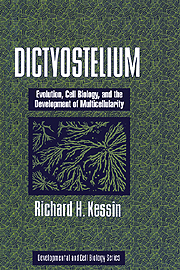Book contents
- Frontmatter
- Contents
- Preface
- 1 A Brief Introduction to Dictyostelium discoideum and its Relatives
- 2 A History of Research on Dictyostelium discoideum
- 3 The Evolutionary Biology of Dictyostelium
- 4 The Genome and Genetics
- 5 Membranes and Organelles of Dictyostelium
- 6 Cell Motility and the Cytoskeleton
- 7 The Transition from Growth to Development: From Starvation to Self-Sustaining cAMP Signal Relay
- 8 Chemotaxis and Aggregation
- 9 Differentiation and Adhesion in the Aggregate
- 10 The Behavior of Cells in the Slug
- 11 Culmination
- 12 Formation and Germination of Spores
- 13 Resources
- References
- Index
- Plate section
3 - The Evolutionary Biology of Dictyostelium
Published online by Cambridge University Press: 07 October 2009
- Frontmatter
- Contents
- Preface
- 1 A Brief Introduction to Dictyostelium discoideum and its Relatives
- 2 A History of Research on Dictyostelium discoideum
- 3 The Evolutionary Biology of Dictyostelium
- 4 The Genome and Genetics
- 5 Membranes and Organelles of Dictyostelium
- 6 Cell Motility and the Cytoskeleton
- 7 The Transition from Growth to Development: From Starvation to Self-Sustaining cAMP Signal Relay
- 8 Chemotaxis and Aggregation
- 9 Differentiation and Adhesion in the Aggregate
- 10 The Behavior of Cells in the Slug
- 11 Culmination
- 12 Formation and Germination of Spores
- 13 Resources
- References
- Index
- Plate section
Summary
During the construction of a fruiting body, the social amoebae show impressive cooperativity. One of the problems that we face is to explain how such cooperativity and the altruism of the stalk cells evolved. There are numerous questions to be asked: what advantage does multicellularity provide? What is unique about the evolution of an organism that increases its size by aggregation rather than feeding and growth? How can parasitism be avoided in the developmental cycle? Can we learn anything that can be exploited as we study the development of these or other aggregative organisms? What is the relationship of the Dictyostelids to other multicellular developing organisms? Before asking such questions, certain fundamentals are required, beginning with the fact that the social amoebae are capable of three developmental cycles – microcyst, macrocyst, and fruiting body formation. Each developmental option stems from a trophic, or feeding, amoeboid cell population. Formation of the microcyst, the macrocyst, and the fruiting body are each highly programmed events. Only the last one receives great attention, but knowing about the first two is essential, because the microcyst and macrocyst pathways may be evolutionary precursors of the fruiting body.
A digression into ecology
The various species of social amoebae were first found in dung and later were recognized to be ubiquitous in forest soils. Soil as an environment has been thoroughly studied, and one of the results of this body of work shows that bacteria, the prey of Dictyostelium, are dispersed in patches in the soil.
- Type
- Chapter
- Information
- DictyosteliumEvolution, Cell Biology, and the Development of Multicellularity, pp. 20 - 39Publisher: Cambridge University PressPrint publication year: 2001
- 3
- Cited by



